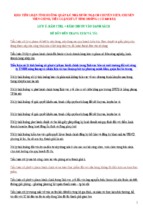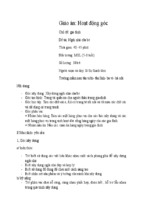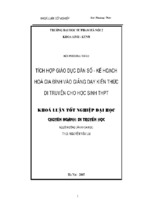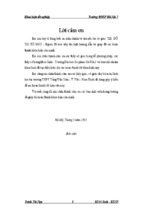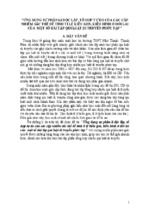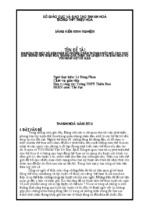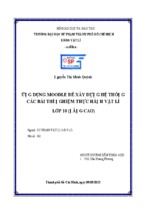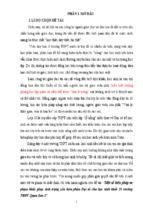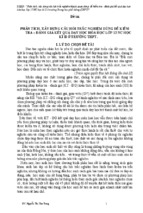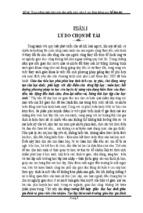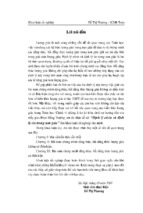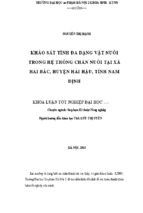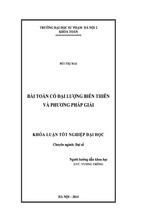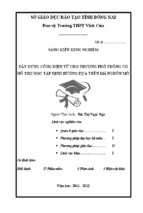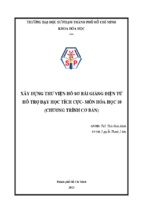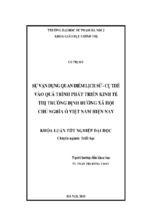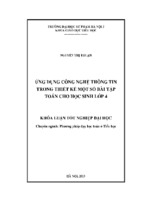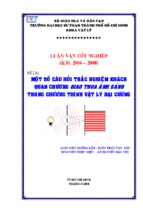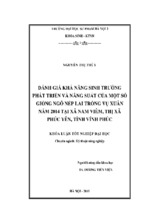1
SỞ GIÁO DỤC VÀ ĐÀO TẠO ĐỒNG NAI
Đơn vị : Trường THPT NGÔ QUYỀN
___________________
Mã số: …………………..
(Do HĐCNSK ghi)
SÁNG KIẾN
USING PRE-READING ACTIVITIES TO HELP
STUDENTS FEEL MORE INTERESTED IN
READING
Người thực hiện: BÙI PHÚ XUÂN
Lĩnh vực nghiên cứu:
- Quản lý giáo dục
- Phương pháp giáo dục
- Phương pháp dạy học bộ môn: Tiếng Anh
- Lĩnh vực khác: ……………………………..
(Ghi rõ tên lĩnh vực)
Có đính kèm: Các sản phẩm không thể hiện trong bản in sáng kiến
Mô hình
Đĩa CD (DVD)
Phim ảnh
(các phim, ảnh, sản phẩm phần mềm)
Năm học: 2019-2020
***
Hiện vật khác
2
SỞ GIÁO DỤC VÀ ĐÀO TẠO ĐỒNG NAI
Đơn vị : Trường THPT NGÔ QUYỀN
___________________
SÁNG KIẾN
USING PRE-READING ACTIVITIES TO HELP
STUDENTS FEEL MORE INTERESTED IN
READING
Người thực hiện: BÙI PHÚ XUÂN
Lĩnh vực nghiên cứu:
- Quản lý giáo dục
- Phương pháp giáo dục
- Phương pháp dạy học bộ môn: Tiếng Anh
- Lĩnh vực khác: ……………………………..
(Ghi rõ tên lĩnh vực)
Năm học: 2019-2020
***
1
TABLE OF CONTENTS
Page
INTRODUCTION …………………………………………..
3
1. Background …………………………………………........
3
2. Reasons for choosing the topic ……………………………
3
3. The scope of the research ……………………………........
4
4. The objective of the research ……………..………………
4
CONTENTS ………………………………………………….
4
I. RATIONALE OF THE RESEARCH ...……………………..
4
II. RESEARCH CONTENTS ……………………………………
6
1. Procedure ………………………………………………
6
Activity 1: Mind-mapping …………………………….
6
Activity 2: Matching ………...………….…………….
8
Activity 3: Competition Game - Hangman ………......
14
Activity 4 : Discussion … …………….…………….
15
Activity 5: Word Sort …………………..……...…….
17
2. Advantages and disadvantages of applying these Pre-
19
reading activities in the class. …………………….
3. Evaluation ……………………………………………….
19
a. Novelty of the research ………………………………
19
b. Evaluation of the research …………………………...
19
c. Applicability of the research ………………………..
20
CONCLUSION ………………………………………………...
21
REFERENCES …………………………………………………
22
Appendix 1 …………………………………………………….
23
Appendix 2 …………………………………………………….
24
2
THÔNG TIN CHUNG VỀ SÁNG KIẾN
1. Tên sáng kiến: Using Pre-Reading Activities to Help Students Feel
More Interested in Reading
2. Lĩnh vực áp dụng sáng kiến: Phương pháp dạy học bộ môn.
3. Tác giả:
- Họ và tên: BÙI PHÚ XUÂN Nam (nữ): Nam
- Trình độ chuyên môn: Thạc sỹ Giảng dạy Tiếng Anh
- Chức vụ, đơn vị công tác: Phó Hiệu trưởng – Trường THPT Ngô Quyền
- Điện thoại: 0918191335
Email:
[email protected]
- Tỷ lệ đóng góp tạo ra sáng kiến (%): 100%
4. Đồng tác giả (nếu có): không
- Họ và tên: …………….......................……........... Nam (nữ): ..................
- Trình độ chuyên môn: …............................................................................
- Chức vụ, đơn vị công tác: …......................................................................
- Điện thoại: …….......……….. Email: .........................................…...........
-Tỷ lệ đóng góp tạo ra sáng kiến (%): ...........................................................
3
TOPIC: USING PRE-READING ACTIVITIES TO HELP
STUDENTS FEEL MORE INTERESTED IN READING
INTRODUCTION
1. Background
N
owadays learning English
is considered to be very essential in our modern
society because it is an international language which is necessary for many
different kinds of activities including education, politics, and socio-economics.
Knowing English also gives you golden chances to get a good job in a
multinational company in Vietnam or finding work abroad. What is more
English is one of the core subjects in all Vietnamese secondary schools, high
schools, colleges and universities. Therefore, classroom teaching is really a
demanding job.
Most Vietnamese teachers have to work with a class of forty five students or
more and there is usually a wide variety of abilities in each class. In reading
class, it is common that teachers always play the centred roles and explain
everything to students while students do nothing. As a result, they find no
pleasure or interest in reading lessons.
2. Reasons for choosing the topic
Through discussions with some of the teachers and students’ in my school I have
found out some problems in teaching and learning reading. Most teachers
choose the teaching career with the hope that they could spark the joy of
learning in their students. However, classroom teaching is a demanding job.
Teachers sometimes recognize that their students find no pleasure in the act of
reading.
Being an English teacher, what should we do to draw students’ attention and to
engage them in reading lessons as well as give them as many opportunities as
possible to take part in active activities in the classroom? This requires both
students’ and teacher’s efforts. However, it is our own job to make the
classroom a lively and communicative place. How can we create such a
classroom?
My experience has taught me that Pre-reading activities are very important for
helping students to understand the background of the text and help students feel
more interested in reading periods. They can spark students’ curiosity and
4
promote a comfortable atmosphere in the classroom. As a result, students will
get more involved in the lesson and a better learning process will take place.
Before you play a sport or do some physical activities it is advisable to warm up
and prepare your body for the upcoming task. It is the same way with reading. It
is better for teachers to give students a chance to warm up and prepare their
mind for reading so that they can perform well and increase their comprehension
in reading lessons.
Allwright (1984) also believes that we can design some activities to attract
students' attention, to help them put aside distracting thoughts and to get them
ready for whatever activities that follow.
3. The scope of the research
The application of these activities was carried out among a class of forty
12-graders at Ngo Quyen High School in some lessons in both first and second
semester of the school year 2019-2020.
These Pre-reading activities finish in about 5 minutes of lesson time, but
some can be even shorter and others can be lengthened.
4. Objective of the research
Among the four skills of learning English, reading is paid much attention
to by the teachers at high schools, however the students feel uninterested in
reading classes because they lack motivation from the beginning of the lessons.
The main objective of the research is to help students feel more interested
in reading lessons by using Pre-reading activities.
CONTENTS
I. RATIONALE OF THE RESEARCH
The importance of reading:
Carrell (1984, p.1) states “reading is by far the most important of the four macro
skills, particularly in English as a second or a foreign language”.
Reading is one important way to improve your general language skills in
English for the following reasons:
Reading can improve your English vocabulary and communication skills.
Reading can help you improve your writing vocabulary.
Reading helps you expand your knowledge and make you smarter.
Reading is a good way to enhance your critical and analytical thinking
skills
Reading will also offer you a chance to travel and use your imagination in
ways you have never imagined.
5
Sookchotirat (2005) suggests that reading skill is the most important skill as it is
the basis of all the success in one’s life. Good readers can gain more knowledge
of any kind from reading. Reading makes the reader more knowledgeable, and
reading makes the reader have wider perspectives and vision. Reading helps the
reader get new ideas leading to cognitive development. When the reader
transfers what they read to apply with their own idea a new perspective or idea is
created.
Harmer (1998: 68) also makes clear that reading is useful for many purposes.
Reading texts provides opportunities to study a language: vocabulary, grammar,
punctuation, and the way we construct sentences, paragraphs and texts. Reading
texts also provides good models for English writing. Lastly, good reading texts
can introduce interesting topics, stimulate discussion, excite imaginative
responses and be the springboard for well-rounded, fascinating lessons.
Yeeding (2007) investigated the effects of pre-reading activities on learners’
motivation and reading comprehension ability. Results showed that the activities
subjects were highly motivated, enthusiastic to read. After the experiment, they
scored significantly higher.
The teaching should accommodate learners’ development of the 4 language
skills. Reading skill, in particular, is the most important skill in second or
foreign language learning (Carrell, 1988).
Reading skill plays such an important role in learning English, however, through
discussions with some of the teachers and students’ in my school I have found
out some problems in teaching and learning reading. Students usually feel tired
and bored at the beginning of the lesson, they study passively and find no
pleasure in the act of reading. Some of them just try to struggle with the text
(e.g.: unknown words and complicated grammar rules) to find the answers to
comprehension questions. It was also very surprising to find out that most of
them did not understand the purpose of reading. They spent nearly 80% of the
time on translating the text word by word into Vietnamese, even a simple one.
Because they thought that they could only understand the text completely if they
translated the text. Besides, some of the students also translate comprehension
questions about the text before giving answers to the teacher.
Through the observation in my classes for many ages I also realized the same
problem that my students did not show much interest in the reading lessons
therefore I decided to design some Pre-reading activities such as Mind-mapping;
Matching; Competition Game – Hangman; Discussion and Word Sort, etc. to see
whether they really help me draw students’ attention to the content of the new
lessons and feel more interested in the reading class.
6
II. RESEARCH CONTENTS
This contains some activities that teachers can use in class and I used
the Units in “English books 11 & 12” as examples in my activities.
1. Procedure:
Step 1: Getting started
From the beginning of the research I had a lot of informal discussions with some
of the teachers and students’ in my school in order to get some initial reflections
on learning and teaching reading in the school.
Step 2: Preparations
Since the innovation involved in variety of activities, the teacher had to
concentrate on selecting and designing the activities based on the topic of each
Unit.
Step 3: Implementing the innovation
Some of the units in English 11 & 12 books were chosen during the innovation
process
Activity 1 : MIND-MAPPING
Al-Jarf (2011) defines mind-mapping as “a graphic organizer in which the major
categories radiate from a central idea and subcategories are represented as
branches of larger branches” (p.4). He also asserts that, this visual tool can be
used to assist learning because it helps students “to generate ideas, take notes,
organize thinking and develop concepts”
This activity is used to:
- attract the students’ attention to the content of the new lesson
-
present concepts in the classroom
- deliver an overview of the topic without superfluous information
- give students a chance to review and widen their vocabulary.
Before teaching the new lesson, the teacher takes a key word in the reading
passage and asks the students to suggest all the words which associate with it.
Write each suggestion on the board with a line joining it to the original word in a
circle, so that you get a “sunray” effect.
Let’s take Unit 1: HOME LIFE (English 12) as an example:
Teacher writes down the word FAMILY on the board and has students
brainstorm all the words they can think of:
7
FAMILY
The word FAMILY may produce something like the sketch below
respect
close-knit family
father
grandparents
household chores
join hands
FAMILY
secure
responsible
take care of
Let’s take Unit 11: SOURCES OF ENERGY - English 11 as another
example:
Teacher writes down the word ENERGY on the board and has students
brainstorm all the words they can think of:
ENEGRY
8
The word ENERGY may produce something like the sketch below
electricity
geothermal
solar
windmill
Non-renewable
heat
ENERGY
fuel
renewable
petroleum
Variation:
The teacher may divide the class into groups of four, give them some
handouts. The groups will work together to identify from the given list as
many words related to the word ENERGY as possible in 3 minutes.
After 3 minutes, the teacher invites the representative of each group to come
to the board and write their list. One point is given for the correct answer.
The group gets the highest points wins the game.
For example in Unit 11: SOURCES OF ENERGY - English
11 List:
Wildlife, power, habitat, fuel, fog, nuclear, extinction, solar, erosion, wind,
water, heat, sewage, geothermal, moon, renewable, Mars, biodiversity, nonrenewable, fertilizer, earthquake, windmill, oil, creature, coal, famine, gas,
rainforest, electricity, petroleum, climate, urbanization, pesticide
Answers:
power, fuel, nuclear, solar, wind, water, heat, geothermal, renewable, nonrenewable, windmill, oil, coal, gas, electricity, petroleum
Activity 2: MATCHING
Matching games improve language, concentration and memory.
We can use this kind of activity to introduce the new lesson as well as draw
students’ attention on the theme of the unit.
9
Let’s take Unit 12: THE ASIAN GAMES – English 11 as an example:
Divide the class into two groups A & B
Stick the pictures of sports on the board.
Distribute the cards of the names of the sports to the students:
Volleyball; Shooting; Weightlifting; Wrestling; Fencing; Table tennis
Call out the pictures in any order and the representatives of each group
should run to the board and stick the names under the pictures.
The group with more correct answers will be the winner.
Give more information about these sports (e.g. in what countries they are
played, indoor or outdoor sports, who are the famous players of these
sports…) and introduce the new lesson.
1
2
3
4
10
5
6
KEY
1. volleyball
2. shooting
3. weightlifting
4. wrestling
5. fencing
6. table tennis
Let’s take Unit 3: WAYS OF SOCIALIZING – English 12 as another
example:
The teacher has students look at the pictures showing facial expressions
and match the pictures with suitable expressions.
1. Crying
2. Smiling
3. Angry
4. Unhappy
5. Surprising
6. Staring
11
1
2
3
4
5
6
12
KEY
1. Crying
2. Smiling
Picture 1
Picture 4
3. Angry
Picture 2
4. Unhappy
Picture 3
5. Surprising
Picture 6
6. Staring
Picture 5
Let’s take Unit 5: TECHNOLOGY AND YOU (English 10) as another
example:
The teacher has students work in groups of four and asks them to look at the
picture of different parts of a computer and match each picture with the word or
phrase in the box
The group that gives the correct answers first is the winner.
1
3
2
4
13
5
6
7
8
printe
r
mous
e
keyboard
speakers
A Central Processing Unit
(CPU)
visual display unit (VDU) or computer screen
Floppy disks
CD ROMS
KEY
1. Picture 1: visual display unit (VDU) or computer screen
2. Picture 2: mouse
3. Picture 3: printer
4. Picture 4: keyboard
5. Picture 5: A Central Processing Unit (CPU)
6. Picture 6: speakers
7. Picture 7: Floppy disks
14
8. Picture 8: CD ROMS
Activity 3: COMPETITION GAME – HANGMAN
As Hadfield (1998) points out that one of the strategies to teach English is by
using games. A game is an activity with rules, a goal and an element of fun.
Wright, Betteridge and Buckby (2005) also agree that language learning is very
hard and efforts are required over a long period of time. Games help the teacher
to create contexts in which language is useful and meaningful, therefore; they
help and encourage students to sustain their interest and work.
The use of Hangman game really helps teachers to motivate students and create
fun atmosphere in the classroom before the new lesson is presented
In this activity students are shown a set of blank letters that match a word or
phrase and they have to guess what these letters are reveal the hidden word.
The teacher divides the class into two groups A & B and draws each of them a
gallows on the board.
Team A
Team B
The teacher explains to students that they are going to play a “Hangman” game.
The teacher explains the rules of the game: students are given a secret word and
the groups will take turn to guess it by telling what letters they think there are in
this word.
If students choose a letter that appears one or more times in the secret word the
letter(s) will be revealed from the blank letters and students can keep on
guessing the next letter. On the other hand, if students guess a letter that is not in
the secret word, then a piece of the man being hanged will be added to the
gallows and they will lose their turn.
Students will get one point for each letter they can guess correctly. When the
game is over, teacher will count how many points each group has collected and
the group with more points will win the game.
Students will have fun playing this game, feel more excited to start the new
lesson and also improve their English at the same time.
Let’s take Unit 6: COMPETITIONS – English 11 as an example:
15
In this lesson, the secret word is “COMPETITIONS” teacher draws the same
number of dashes as the number of letters in this word. For this word, teacher
would need 12 dashes like this: _ _ _ _ _ _ _ _ _ _ _ _
Let’s take Unit 4: SCHOOL EDUCATION SYSTEM – English 12 as another
example:
In this lesson, the secret word is “EDUCATION” teacher draws the same
number of dashes as the number of letters in this word. For this word, teacher
would need 9 dashes like this: _ _ _ _ _ _ _ _ _.
Activity 4: DISCUSSION
We use “Discussion activities” to
- give students an opportunity to talk about the things they really care about
- encourage students to think more critically and actively participate in the
classroom
- increase students’ interests and engagement in reading lessons
- arouse students’ curiosity about a certain topic
- help students process the information rather than simply receive
- help develop students’ habits of collaborative learning.
Let’s take Unit 11: BOOKS– English 12 as an example:
The teacher has students work in groups of four and discuss some of the
questions relating to the topic of the reading lesson.
The teacher invites some students to report their ideas in front of the class, gives
comments and then starts the new lesson.
1. Do you like reading? Why or why not?
2. Which is your favourite book?
3. Do you usually read for leisure or for study purposes?
4. What do you think are the benefits of reading in general?
5. Do you think there is a difference between reading habits in the
past and in the present day?
6. What kinds of books did you read when you were a child?
7. Which book has affected or influenced you the most so far?
8. Do you think people don’t read enough books these days?
9. What is the impact of e-books on reading habits?
10. In your opinion, will paper books disappear completely in future?
16
Let’s take Unit 1: HOME LIFE (English 12) as another
example:
Students are asked to work in groups of four and discuss some of the questions
relating to the topic of the reading lesson.
The teacher invites some students to report their ideas in front of the class, gives
comments and then starts the new lesson.
1. How much time do you manage to spend with members of your family?
2. In what way is your family important to you?
3. Did/Do you get well with your family? Why?
4. Who are you closest to in your family?
5. Should we rely heavily on our families or is it better to try to be
independent?
6. What sorts of things do you like to do together?
7. What is your responsibility in the family?
8. Which are more important to you: your family or your friends?
Let’s take Unit 13: HOBBIES (English 11) as another example:
The teacher has students work in groups of four discuss some of the questions
relating to the topic of the reading lesson and share their opinions about various
leisure activities
The teacher invites some students to report their ideas in front of the class, gives
comments and then starts the new lesson.
1. Do you have any hobbies?
2. What do you like to do in your free time/spare time?
3. Do you require any special equipment for your hobby?
4. What hobbies are popular in Viet Nam?
5. Is it important to have a hobby?
6. Is it harmful to spend too much time on a hobby?
7. What sort of hobbies would you like to try in the future?
17
Let’s take Unit 14: INTERNATIONAL ORGANIZATIONS (English
12) as another example:
The questions that are related to the topic of the reading passage help
arouse students’ curiosity and students are eager to read the reading passage to
satisfy their curiosity about the topic.
1. Do you know anything about the Red Cross?
2. What is its mission?
3. Where is its headquarters?
4. Who initiated the Red Cross?
5. Does The Red Cross provide medical aid and other help to victims
of natural disasters?
6. How many colours does the symbol of the Red Cross have?
Activity 5: WORD SORT
The use of Word Sort is very helpful for all kinds of students. It is an
interactive activity providing students with oral language development
opportunities and also arousing students’ interests in the new lesson.
Let’s take Unit 12: WATER SPORTS– English 12 as an example:
The teacher has the class work in groups of 4
The teacher writes the headings on the board.
(jobs, animals, water sports and kinds of books)
The teacher asks the students to look at the words in the box and put each word
under the correct heading.
The teacher gives an A0 sheet of paper to each group to write the words on, and
then stick these sheets of paper on the board.
The group with the most correct words wins the game.
18
Teacher
Dictionary
Dentist
Scuba Diving
Pilot
Giraffe
Whale
Tiger
Accountant
Hairdresser
Comic
Romance
Fairytale
Synchronized Swimming
Wind Surfing
Canoeing
Craft book
Swimming
Monkey
Water Polo
Cookery book
Designer
EncyclopediaThriller
Engineer
Historical novel
Rhinoceros
Actress
Leopard
Bear
Surfing
Water Skiing
Elephant
Sailing
Fox
Science fiction
Lion
Jet Skiing
Suggested answers:
Jobs
Animals
Water sports
Kinds of books
Teacher
Dentist
Leopard
Tiger
Surfing
Sailing
Comic
Dictionary
Pilot
Lion
Swimming
Romance
Engineer
Monkey
Wind Surfing
Thriller
Designer
Giraffe
Jet Skiing
Craft book
Accountant
Elephant
Water Skiing
Fairytale
Hairdresser
Rhinoceros
Scuba Diving
Science fiction
Synchronized Swimming
Cookery book
Actress
Fox
Businessman
Whale
Water Polo
Historical novel
Carpenter
Bear
Canoeing
Encyclopedia

